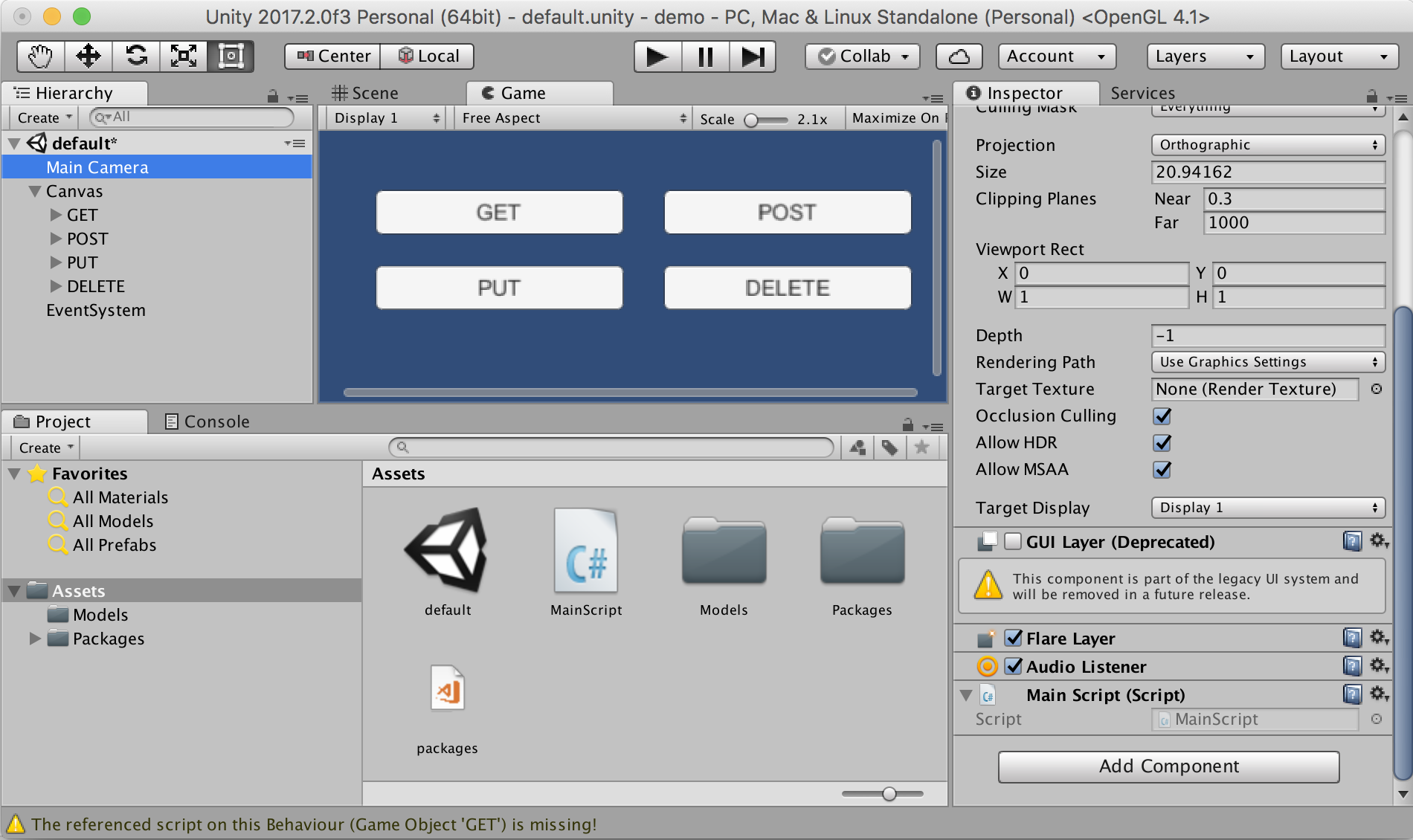RestClient for Unity 🤘
This HTTP/REST Client is based on Promises to avoid the Callback Hell ☠️ and the Pyramid of doom 💩 working with Coroutines in Unity 🎮, example:
var api = "https://jsonplaceholder.typicode.com";
RestClient.GetArray<Post>(api + "/posts", (err, res) => {
RestClient.GetArray<Todo>(api + "/todos", (errTodos, resTodos) => {
RestClient.GetArray<User>(api + "/users", (errUsers, resUsers) => {
if(err != null){
EditorUtility.DisplayDialog ("Error", errTodos.Message, "Ok");
}
});
});
});But working with Promises we can improve our code, yay! 👏
RestClient.GetArray<Post>(api + "/posts").Then(response => {
EditorUtility.DisplayDialog ("Success", JsonHelper.ArrayToJson<Post>(response, true), "Ok");
return RestClient.GetArray<Todo>(api + "/todos");
}).Then(response => {
EditorUtility.DisplayDialog ("Success", JsonHelper.ArrayToJson<Todo>(response, true), "Ok");
return RestClient.GetArray<User>(api + "/users");
}).Then(response => {
EditorUtility.DisplayDialog ("Success", JsonHelper.ArrayToJson<User>(response, true), "Ok");
}).Catch(err => EditorUtility.DisplayDialog ("Error", err.Message, "Ok"));Demo ⏯
Do you want to see this beautiful package in action? Download the demo here
Installation 👨💻
Unity package
Download and install the .unitypackage file of the latest release published here.
Nuget package
Other option is download this package from NuGet with Visual Studio or using the nuget-cli, a NuGet.config file is required at the root of your Unity Project, for example:
<?xml version="1.0" encoding="utf-8"?>
<configuration>
<config>
<add key="repositoryPath" value="./Assets/Packages" />
</config>
</configuration>The package to search for is Proyecto26.RestClient.
Getting Started 📚
The default methods (GET, POST, PUT, DELETE) are:
RestClient.Get("https://jsonplaceholder.typicode.com/posts/1").Then(response => {
EditorUtility.DisplayDialog("Response", response.text, "Ok");
})
RestClient.Post("https://jsonplaceholder.typicode.com/posts", newPost).Then(response => {
EditorUtility.DisplayDialog("Status", response.statusCode.ToString(), "Ok");
})
RestClient.Put("https://jsonplaceholder.typicode.com/posts/1", updatedPost).Then(response => {
EditorUtility.DisplayDialog("Status", response.statusCode.ToString(), "Ok");
})
RestClient.Delete("https://jsonplaceholder.typicode.com/posts/1").Then(response => {
EditorUtility.DisplayDialog("Status", response.statusCode.ToString(), "Ok");
})
But we are going to create a class "User" and the HTTP requests to load JSON data easily:
[Serializable]
public class User
{
public int id;
public string name;
public string username;
public string email;
public string phone;
public string website;
}
- GET JSON
var usersRoute = "https://jsonplaceholder.typicode.com/users";
RestClient.Get<User>(usersRoute + "/1").Then(firstUser => {
EditorUtility.DisplayDialog("JSON", JsonUtility.ToJson(firstUser, true), "Ok");
})
- GET Array
RestClient.GetArray<User>(usersRoute).Then(allUsers => {
EditorUtility.DisplayDialog("JSON Array", JsonHelper.ArrayToJsonString<User>(allUsers, true), "Ok");
})
Also we can create different classes for custom responses:
[Serializable]
public class CustomResponse
{
public int id;
}
- POST
RestClient.Post<CustomResponse>(usersRoute, newUser).Then(customResponse => {
EditorUtility.DisplayDialog("JSON", JsonUtility.ToJson(customResponse, true), "Ok");
})
- PUT
RestClient.Put<CustomResponse>(usersRoute + "/1", updatedUser).Then(customResponse => {
EditorUtility.DisplayDialog("JSON", JsonUtility.ToJson(customResponse, true), "Ok");
})
Custom HTTP Headers and Options 💥
HTTP Headers, such as Authorization, can be set in the DefaultRequestHeaders object for all requests
RestClient.DefaultRequestHeaders["Authorization"] = "Bearer ...";
Also we can add specific options and override default headers for a request
var requestOptions = new RequestHelper {
url = "https://jsonplaceholder.typicode.com/photos",
headers = new Dictionary<string, string>{
{ "Authorization", "Other token..." }
}
};
RestClient.GetArray<Photo>(requestOptions).Then(response => {
EditorUtility.DisplayDialog("Header", requestOptions.GetHeader("Authorization"), "Ok");
})
And later we can clean the default headers for all requests
RestClient.CleanDefaultHeaders();
Collaborators 🥇
| Diego Ossa | Juan Nicholls |
Credits 👍
Supporting 🍻
I believe in Unicorns 🦄 Support me, if you do too.
Happy coding 💯
Made with ❤️


